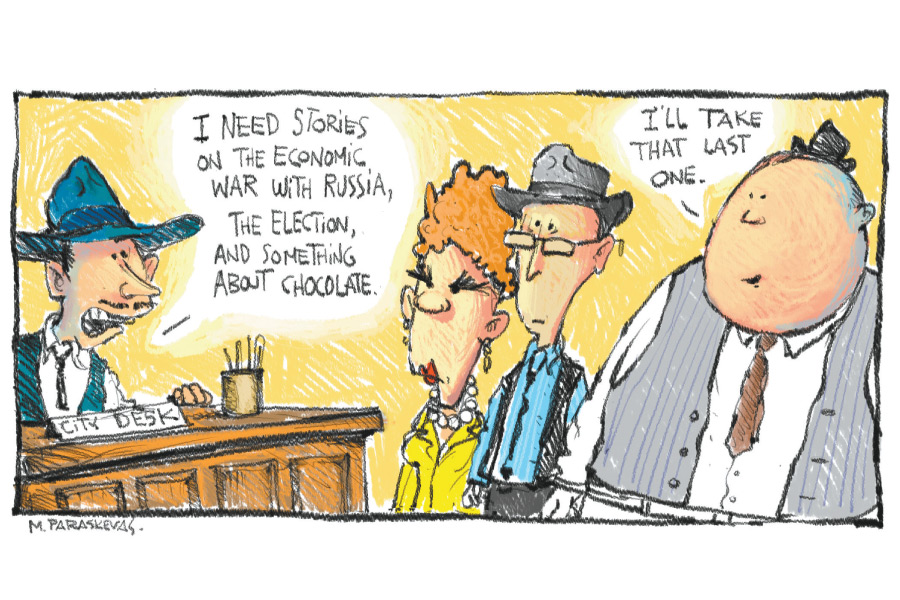Oligarchs and Chipotle: What's Up With The New York Times?

What is going on with The New York Times? It’s been getting really weird. We count on teams of Times reporters to go out and cover important front-page stories defending the Constitution and the poor, attacking foreign dictators, corruption and crime. But then, three weeks ago, there it was, a new story pointing out that the recently constructed 90-story-tall luxury apartment towers in midtown are—hang onto your hats here—owned largely by rich foreigners. They had line drawings of the five largest such structures, their facades made into grids of boxes with the black boxes showing foreign-owned apartments and the white boxes showing apartments owned by Americans. Some of the buildings were half- or even three-quarter black-box owned.
I wish I could say I read this from the beginning, but when I got back from vacation it was already the last of a five part series. The Times reporters had combed through deeds, broker contracts and shell company tax return reports to break open these corporations, going back into shareholder records to learn who actually owns the apartments.
Many are apparently owned by Saudi princes, Colombian drug lords or Pakistani generals—I didn’t get to see the earlier stories—but this last story in the series was entitled “Powerful Russians Commanding Park Views.”
Yes, it’s true. Rich foreigners own many of these apartments.
Here’s a passage from the last of the articles about the Russian oligarchs.
“Mr. Egiazaryan’s lawyers had contended that one of their client’s rivals in the hotel deal was behind Mr. Zalmayev’s campaign, suggesting that Mr. Vavilov was merely a front. But documents produced in the discovery process and reviewed by the Times, show that…”
I’ve been trying to understand what made the Times editors decide to throw all these resources at this story. The City Room is now in a tall new building in midtown. It has glass on every side. Perhaps all the editors and reporters were sitting around up there—maybe it’s on a top floor—and had been looking out at the new residential skyscrapers every day, and one of the editors said, “Who do you think lives in those apartments? Let’s find out.” So they sent a team out.
A few days later, however, there was another story by a team of reporters highlighted on the front page. The Chipotle restaurant chain says what it serves is healthy and good for you. But is it? You assemble what you eat from a choice of meats, fillings, etc. There’s maybe 10,000 ways you can do it. But the Times was up for the task. There’s a Chipotle down the street. They showed two graphs on the front page. Both were bar graphs. One showed the calorie count of a wide variety of assemblages that the Times researchers created, with the bars showing the percentages of the assemblages that weighed in at 600 calories, then 700, then 800 and so forth, all the way up to 2,000 calories, which is what experts say is the number of calories we should consume in a day. There was a thin vertical line at 1,000. The Times was giving Chipotle a break, saying go ahead, consider your meal there half your calories for the day. That’s how they got to 1,000. Before 1,000 was good, after 1,000 was bad. You could see that the tallest bars were mostly on the bad side of 1,000 and only a few were on the good. So eating well is possible if you’re careful. They gave examples.
Another bar graph was for sodium. They had a vertical line where half the daily requirement of salt was. Again, Chipotle assemblages strayed over the line toward the high end.
Now I know that the Times can put their very best reporters on such a case. There are Pulitzer Prize–winning writers on their staff. So it’s no good saying that the decline in print journalism has decimated the quality of the reporting. Here, for example, is award-winning prose from a story they published in the same issue by one of their great reporters, Pete Wells, about a spicy tuna sushi roll.
“Nobody who has had Shuko’s version, though, is going to forget it. The heat comes in gusts that keep getting stronger until you can’t do anything but hold on. The chiles scour your tongue, cauterizing it. The melting oils from the tuna belly blanket your entire mouth, trying to restore the peace. The two sides, almost evenly matched, fight for control, and you are the battlefield.”
And that wasn’t even on the front page.
No, I think we have to look deeper into why this change in direction has suddenly seized the editors of the Times.
Frankly, the important stuff is just a mess. The Times championed the overthrow of Muammar Gaddafi in Libya. But afterward, the country shattered into tribes. Now this week, ISIS has Russian jets they bought from Iran flying air strikes on tribes not getting with the new ISIS program. Also this week, we have Hezbollah in Lebanon coming to fight against Syria. And there’s Turkey arranging for American trainers to come and work teaching rebel fighters not connected up with ISIS how to overthrow Syria. Apparently we are going to fingerprint these rebel fighters and if they are on somebody’s black list, not give them the needed training and weaponry. We send them away.
Here’s an imaginary conversation from the Times’ City Room.
Editor: I want a group of reporters embedded in that new ISIS controlled territory and report back with what you have learned. Volunteers? No volunteers?
I think the Times should send out a team to do a five-part series on chocolate. Chocolate is in crisis. It reminds me of when Coca-Cola abandoned classic Coke back in the 1980s. Who can forget those days? People jumping out of windows. People running screaming through the streets.
And with chocolate, there is no turning back as there was with Coca-Cola, whose management hurriedly brought back the original formula. With chocolate, the price of a pound of beans has doubled since the beginning of the year because suddenly the people who live in China and India have discovered chocolate.
Nobody asked these two-and-a-half billion people to do that. Did you tell them? I didn’t. Having that many new eager chocolate eaters is rocking the imbalance between supply and demand. And the price (make us a graph, NY Times editors) is skyrocketing.
I heard about this on NPR. Ecuador used to be a major producer of the world’s chocolate. It grows on tree branches as little rosy yellow berries inside pods the size of footballs. But in 1912, the disease Witches’ Broom ruined the berries of almost every cocoa tree in Ecuador, essentially wiping out the industry.
Then, it turned out, a very little man named Homer Castro began experimenting with different strains of chocolate in Ecuador and elsewhere in the world and after years and years of mating opportunities, came up with a very bitter chocolate that doesn’t get Witches’ Broom. Then, in the 1980s, he died in a car accident. Now it turns out if you let the beans sit in the sun in burlap bags for three days, the bitterness fades away. The new bean pods are the size of basketballs, and the taste of the beans is close to regular chocolate, but different. It’s 5 percent of many chocolate treats now, heading for 10 percent. We can get used to it.
The Times could show us a graph.



